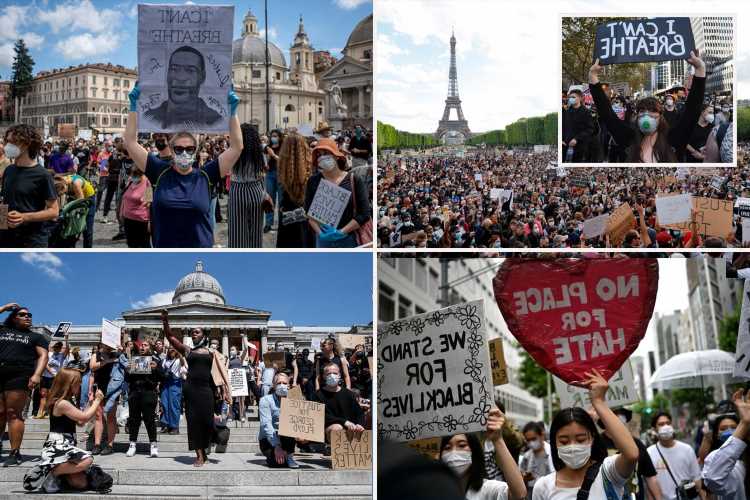THE DEATH of George Floyd last May sparked months of global Black Lives Matter protests and a worldwide racial justice movement that has continued over eleven months.
Activists have continued to call for justice for Floyd, 46, in demonstrations that were sparked anew in the final week of the trial of Derek Chauvin – the ex-Minneapolis police officer charged with killing him.
The jury on Tuesday found Chauvin guilty on all three charges in only its second days of deliberation.
The city of Minneapolis had become a fortress in recent days as local officials prepared for protests and potential riots to kick off if Chauvin, 45, is found not guilty.
Floyd died last May 25 following an arrest during which Chauvin placed a knee on his neck for 9 minutes and 29 seconds while Floyd pleaded, “I can’t breathe.”
Chauvin and three other officers had been responding to the scene after being called by an employee at a nearby Cup Foods store, accusing Floyd of having used a fake $20 bill.
Caught on video, those tragic final moments led to widespread protests and riots across the US against police brutality and racism.
While the deaths of other black men and women while in police custody have previously caused waves of angry protests to erupt, the video of Floyd sparked a more sustained movement than any prior.
Coupled with the death of 25-year-old EMT Breonna Taylor in her home in March last year and the increased impact of the coronavirus pandemic on black communities, tens of millons took to the streets worldwide.
In recent years, the Me Too movement fuelled large marches in 2017 and 2018, and the Parkland school shooting led to the March of our Lives demonstration.
Both paled in comparison to the numbers Floyd's death drew out.
CNN reports that before Floyd's death, the 2017 Women's March was estimated to be the highest estimate for a US protest.
That saw 4.6million Americans come out to demonstrate.
Polls indicated that as many as 21million Americans had attended a Black Lives Matter protest in the first two weeks of May and many contineud throughout the summer.
Not only did the video of Floyd's death bring people out to march but it lead to louder calls for police accountability and defunding law enforcement than ever before.
It also caused a wave of changes as companies and branded reckoned with the impact of racist names, mascots and images.
These were met with backlash from Republicans as they blasted the changes as too "woke" and part of a dangerous "cancel culture."
Former President Donald Trump vigorously defended statues paying homage to the likes of Presidents George Washington and Abraham Lincoln.
They had been targeted by the Black Lives Matter movement for owning slaves and mistreating native Americans respectively.
Trump slammed activists calling for the removal of statues and at times, attempting to remove them themselves.
While he voiced horror at the video of Floyd's death, he sharply called for "law and order" as several protests turned violent and looting began.
He also continued to back law enforcement as he threatened action if local lawmakers did not end the violence in their cities.
As cities were forced to introduce curfews in an attempt to calm down the wave of outrage in the weeks immediately after Floyd's, hundreds of arrest were made.
"What started in 2014 in the streets of Ferguson has just spread across the country," Publisher and former St. Louis Alderman Antonio French told CNN.
"Having this kind of turmoil with that many unemployed young people, with this kind of national leadership that has zero empathy … this is the makings of real conflict, and I think we should be really concerned."
The outrage was not contained to the US alone.
Protests began from Berlin, London, Paris and Vancouver, British Columbia, to capitals in Africa, Latin America and the Middle East.
In London, thousands gathered United States Embassy in defience of strict coronavirus lockdowns.
They screamed “I can’t breathe” and “No justice, no peace” before marching to Grenfell Tower, the site of a devastating fire that killed many immigrant residents in 2017.
Source: Read Full Article














